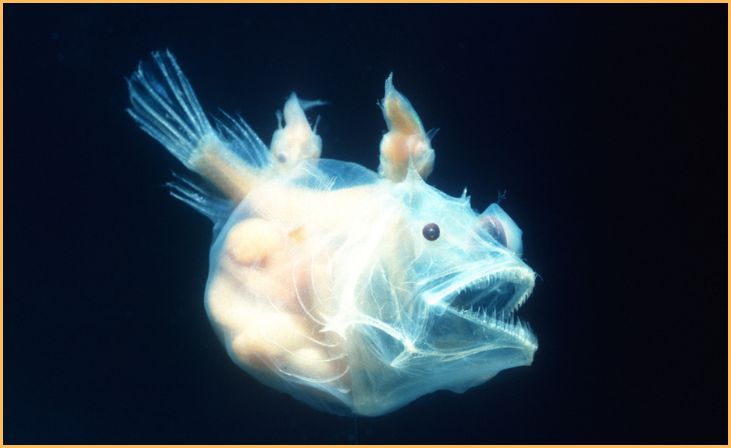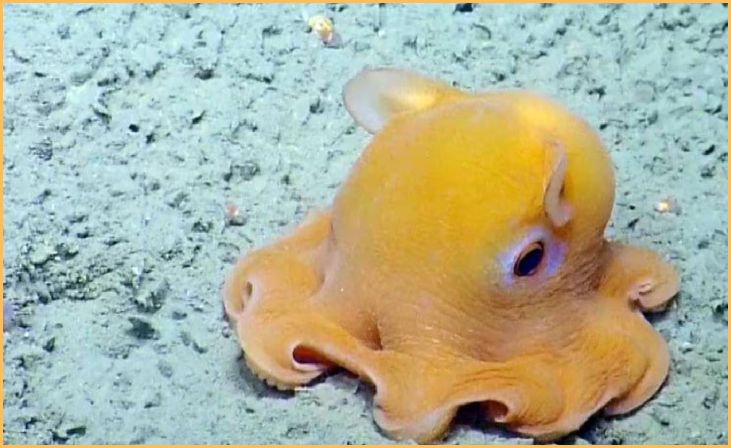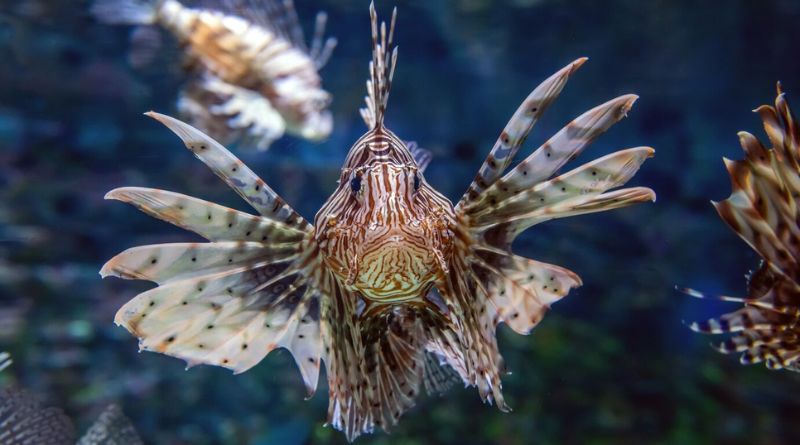As we conclude our journey into the abyss, the “7 Strangest Deep Sea Creatures” showcase the incredible diversity and resilience of life in the ocean’s depths. These extraordinary beings remind us of the boundless wonders awaiting discovery beneath the surface. Let this exploration inspire awe and appreciation for the mysterious and fragile ecosystems that shape our planet’s underwater realms.
7 Strangest Deep Sea Creatures
The Anglerfish (Melanocetus johnsonii)

The anglerfish, a denizen of the deep-sea abyss, presents itself with an otherworldly and grotesque appearance, concealing unique adaptations crucial for its survival in the abyssal darkness. At the tip of a modified dorsal spine, the anglerfish showcases a mesmerizing bioluminescent lure, dangling enticingly in front of its mouth. This luminous bait serves as a beacon, luring unsuspecting prey in the inky depths where sunlight fails to penetrate.
Intriguingly, the female anglerfish dwarfs her male counterparts, and a peculiar mating ritual involves the male fusing to the female, becoming a parasitic mate. In this symbiotic relationship, the male gains sustenance, while simultaneously aiding in reproduction, demonstrating the extraordinary strategies evolved in the depths.
Also Read: Biggest Fish That Command Awe and Wonder
The Goblin Shark (Mitsukurina owstoni)
Descending to staggering depths exceeding a thousand meters, the goblin shark emerges as a living fossil, captivating scientists and enthusiasts alike with its truly bizarre appearance. Recognizable by its elongated snout and protruding jaws, this deep-sea inhabitant boasts a jaw mechanism allowing it to extend its mouth with remarkable speed, ensnaring prey in the blink of an eye.
The goblin shark’s distinctive pinkish hue results from the transparency of its skin, revealing the intricate network of blood vessels beneath. This enigmatic creature stands as a testament to the marvels of evolution, showcasing an adaptation finely tuned to the challenges posed by extreme environmental conditions.
The Giant Tube Worms (Riftia pachyptila)
Thriving near hydrothermal vents on the ocean floor, giant tube worms emerge as a testament to life’s resilience in the face of extreme conditions. These remarkable creatures can extend several feet in length and lack a conventional digestive system. Instead, they form a symbiotic relationship with bacteria residing within their bodies.
These bacteria, utilizing chemicals emanating from hydrothermal vents, engage in chemosynthesis, producing organic matter that sustains both the tube worms and the surrounding deep-sea ecosystem. This intricate dance of life showcases the adaptability and interconnectedness of species in the depths.
The Deep-Sea Dragonfish (Grammatostomias flagellibarba)

Inhabiting lightless depths beyond the reach of sunlight, the deep-sea dragonfish unveils a suite of intriguing features essential for its survival. Equipped with a bioluminescent chin barbel and specialized photophores adorning its body, this fish generates its own light. This luminosity serves multiple purposes, from attracting prey to facilitating communication with others of its kind in the lightless expanse.
Adding to its arsenal of adaptations, the dragonfish possesses an extendable stomach, enabling it to consume prey larger than its own size, exemplifying the ingenious strategies devised by deep-sea denizens in navigating their pitch-black environment.
The Blobfish (Psychrolutes marcidus)
Affectionately termed the “blobfish,” this deep-sea dweller presents a peculiar appearance owing to its gelatinous and malleable body. Inhabiting the profound waters off the coasts of Australia and New Zealand, the blobfish’s unique physique serves as an adaptation to the intense pressure prevalent in its environment.
Despite its seemingly unappealing appearance when out of water, the blobfish assumes a more conventional fish shape when in its natural habitat, highlighting the remarkable ability of organisms to adapt and thrive in extreme conditions. The blobfish stands as a testament to the diverse and resilient life forms that populate the mysteries of the deep sea.
The Viperfish (Chauliodus sloani)
Dwelling in the abyssal depths, the viperfish emerges as a formidable deep-sea predator, distinguished by its menacing appearance and a set of teeth that instills terror in its prey. Inhabiting depths of up to 2,000 meters, this creature employs bioluminescent photophores along its body, strategically placed to attract unsuspecting prey in the darkness.
With an extendable jaw and razor-sharp teeth, the viperfish can capture and consume prey larger than its own size. Its elongated dorsal fin and dark coloration contribute to its stealth as it navigates the profound depths, exemplifying the adaptations necessary for survival in the unforgiving conditions of the deep ocean.
The Dumbo Octopus (Grimpoteuthis)

Named after the beloved Disney character Dumbo, the dumbo octopus adds a touch of charm to the mysterious deep-sea landscape. Flourishing at extreme depths, reaching as far as 7,000 meters, these unique octopuses showcase a distinctive mode of propulsion through their ear-like fins.
Also Read: Signs Of Snakes Around Your House
Unlike their counterparts, dumbo octopuses lack an ink sac for defense, relying instead on their remarkable color-changing abilities to camouflage in the shadowy surroundings. With gelatinous bodies and a captivating appearance, dumbo octopuses serve as enchanting ambassadors of the diverse and often unseen life that populates the depths of our planet’s oceans.
Conclusion
As we conclude our journey into the abyss, the “7 Strangest Deep Sea Creatures” showcase the incredible diversity and resilience of life in the ocean’s depths. These extraordinary beings remind us of the boundless wonders awaiting discovery beneath the surface. Let this exploration inspire awe and appreciation for the mysterious and fragile ecosystems that shape our planet’s underwater realms.
FAQs
Deep-sea creatures possess unique adaptations, such as bioluminescence and extreme pressure tolerance, enabling them to thrive in the harsh, light-deprived conditions of the ocean depths.
Most deep-sea creatures are not harmful to humans, as they reside in remote areas. However, some possess adaptations like venomous spines for defense, emphasizing the importance of caution and respect for their habitats.







